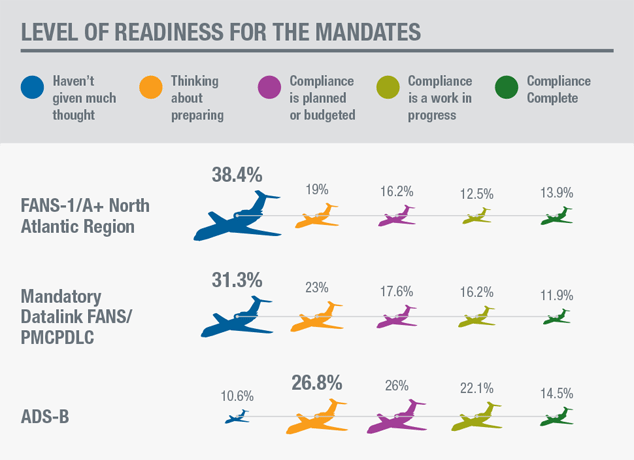[Avionics Today 10-28-2015] With the Future Air Navigation System (FANS) 1/A+, Protected Mode Controller Pilot Data Link Communications (PM-CPDLC) and Automatic Dependent Surveillance-Broadcast (ADS-B) mandate compliance dates in the U.S. and Europe looming, operators should look to formulate their own roadmaps to prevent losing access to airspace. This was the advice of experts during the Wednesday Avionics Magazine webinar “Placing Your Aircraft on the Fast Track to Mandate Compliance,” sponsored by Honeywell, who spoke to how operators can forge their own paths to compliance with airspace mandates on the horizon.
 |
| A chart of mandates and readiness. Photo: Honeywell |
ADS-B
“If you’re looking at keeping your aircraft past 2020 [we urge you to] get the hardware installed and become mandate compliant earlier because later you may end up with restrictions on your aircraft because you physically can not get your aircraft scheduled to meet the mandate,” said Tom Dooling, senior manager of technical sales at Honeywell, speaking to the ADS-B mandate in particular. Dooling estimates that there are approximately 120,000 operators that still need to equip with ADS-B before the mandate kicks in, with 750 repair stations capable of the installation.
To fulfill the ADS-B requirement, an operator will need to equip with either an integrated or stand alone transponder. In some cases an operator can upgrade a Mode S transponder to full ADS-B compliance, but the required upgrade is based on the aircraft’s existing equipment. Operators also require a position source in the United States and, in many areas, a source that must be Selective Availability (SA) capable, which essentially equates to having a Wide Area Augmentation System (WAAS) GPS position source, according to Dooling.
“Many of the older GPS are not capable of being upgraded to the WAAS capability so you would actually have to replace them,” said Dooling, who noted that there are considerations including whether to replace the GPS with a form fit GPS or one that is lighter and has expanded capabilities. The modification to equip for ADS-B will also likely include software changes for an integrated cockpit to include indicators on the displays.
For aircraft that operate below 10,000 feet, an operator can also equip with a Universal Access Transceiver (UAT) in the U.S. Dooling recommends operators check with their Maintenance, Repair and Overhaul (MRO) facility or service provider as to whether their operational profile and region will enable them to equip with a UAT as opposed to a Mode S transponder.
FANS 1/A+ and PM-CPDLC
The North Atlantic Tracks (NAT) FANS 1/A+ mandate and the European PM-CPDLC mandates, also come with equipage challenges.
FANS 1/A+ uses the global Aircraft Communications And Reporting System (ACARS) network, which leverages a global footprint for Air Traffic Control (ATC) for text messaging between controllers and pilots, and additional functionality. It is intended for use mainly for flights across the North Atlantic oceanic space, but some of the functionality will push into the continental U.S. for departure clearances. There are two trial sites that are currently set up at Memphis and Newark airports. It’s projected that in excess of 50 airports will be able to roll out these digital departure clearances by 2018.
“The reason [for the FANS 1/A+ mandate] is to increase efficiency with the air traffic flying through these various airspaces. It provides a preferred more direct transatlantic routing of aircraft through transatlantic routes that can become congested. The idea is to enable pilots to fly within those airspaces more efficiently and to allow the air traffic control and the governing bodies to be able to streamline the traffic going through those. It will also provide fewer delays on the ground with aircraft awaiting clearances. It also helps out with some of the tracking and increases safety across the board,” explained Ben Brimhall, senior manager of product marketing at Honeywell.
PM-CPDLC has also been established to help aircraft fly preferred routes, but instead of using the ACARS network, it uses the Aeronautical Telecommunication Network (ATN) protocol.
The PM-CPDLC mandate was originally set for February of this year, but regulators pushed it to 2020, and we can expect to see further modifications on the horizon. “There are still some additional changes as to what we are being asked to do for PM-CPDLC, so we would actually expect that mandate to push out a little bit more,” Brimhall said.
To comply with the upcoming FANS 1/A+ and CM-CPDLC mandates, operators will need to upgrade their Communication, Navigation and Surveillance (CNS) equipment onboard. The data link communications management component is the most heavily impacted. Honeywell has a standalone datalink unit known as Mark III Communications Management Unit (MK III CMU), which can lay down the baseline for compliance, while Rockwell Collins offers its CMU-4000 and Universal Avionics has the UniLink 800/801 FANS 1/ACMU, all of which can modify the data link unit to be FANS compliant. The Satellite Communications (Satcom), Flight Management System (FMS) and VHS transceiver may all also require modification, meaning that FANS 1/A+ and CM-CPDLC are two mandates that each operator will need to look into in regards to their own, particular aircraft avionics.
“It’s a unique situation because every aircraft flying probably has a unique configuration and a unique set up, and so some equipment on board may be compliant, other aircraft may not have the full solution. From a broad perspective, what we need to do is to be able to offer, implement and install a complete end-to-end fully integrated system that provides complete compliance,” said Brimhall.